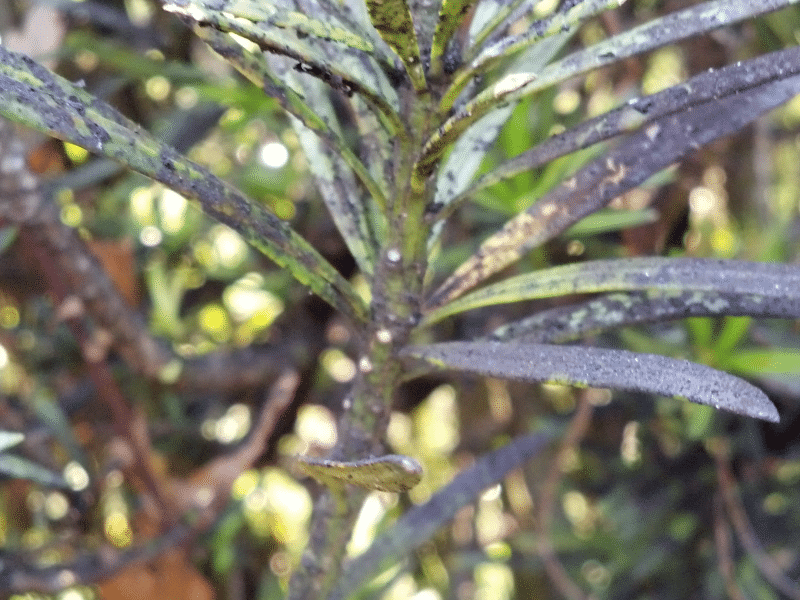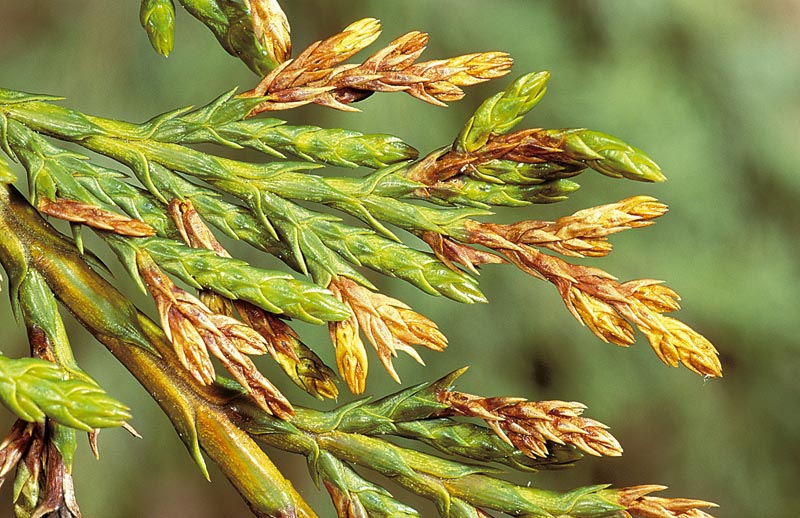Reviews for Thuja Green Giant Trees From Anythinggreencom
Thuja 'Greenish Giant' is susceptible to very few pest or disease problems. Most gardeners will never have whatever problems with their 'Dark-green Giants'. But if you do encounter pests and diseases of Thuja Greenish Behemothic, here is how to solve them in our list of Thuja Green Giant Tree Problems.
Thuja Green Giant arborvitae shrub is 1 of our most pop ornamental trees for hedges, privacy screens, and windbreaks. It is a fast growing evergreen shrub, adaptable to a wide range of soil atmospheric condition, and grows fast. With a pyramidal shape, information technology can grow upwards to 20-40 feet tall and up to 20 anxiety wide at maturity. Thuja has an extremely fast growth rate of three-v feet per year one time established in full sunday or partial shade.
It is usually very disease resistant with the proper Green Giant Arborvitae care and preventative measures. The arborvitae leaf should stay green all year round and will exist the first indicator of something incorrect if leafage color changes.
The emerald greenish Thuja plicata is grown in the U.s. department of agriculture plant hardiness zones five-9. So be certain you lot are growing in the correct zones first and foremost…
Most Popular Evergreen Trees
Here are some normal Arborvitae diseases and how to fix them:
- Arborvitae Turning Brown Leaves
Retrieve, newly planted copse and shrubs need lots more water than established plantings. For the first few months, you should h2o your trees every day or two that it doesn't pelting. At least a gallon of h2o per week is adequate. After a few months of growth, when their root systems have penetrated into the soil effectually them, the rich Greenish Giant evergreens should exist fine with only an inch of rain or supplemental water per calendar week or two. They are moderately drought tolerant, besides as tolerant to rut and humidity. 
If some branch tips are turning brown on your newly planted 'Light-green Giants', it might be because they aren't getting plenty h2o .
- Arborvitae Turning Yellow
Use a wearisome release counterbalanced fertilizer labeled for large evergreen trees and shrubs and follow characterization directions. Nosotros prefer the more than expensive slow-release or organic fertilizers since they don't need to be reapplied as often. Normally, only once a yr is plenty. Thuja 'Green Giant' tin can sometimes plough a lilliputian yellowish in cold winters, especially if it's in an exposed, windy location. This is normal and the Arborvitae tree should be its night green cocky again when bound returns. 
If, after a few weeks in the ground, your 'Green Giants' appear a little yellowish rather than overall bright green, they could be suffering from nutrient deficiency. We did fertilize when we planted them, but now is the time to begin fertilizing again.
- BugsBagworms on Arborvitae
They make the little stick-tents out of silk they produce and pieces of the needles and institute foliage that they eat. Open up one upwards and run across the green caterpillar inside. These will come up out at night and eat a few needles on your 'Green Behemothic', but rarely are there enough of them to impairment the tree. Squish them or plop into a bucket of soapy water. Be certain to check nearby trees (even deciduous trees of other species may be afflicted). If you recollect the infestation is serious enough to stunt the tree's growth, you can spray with a commercial formulation of Bt. Bt is short for Bacillus thuringiensis, a naturally occurring bacteria that kills caterpillars when they swallow leaves or needles that have been sprayed with it. Bt is one of the safest natural pesticides for decision-making caterpillar pests on plants and is accepted as organic. Only insects that eat the sprayed foliage are killed. This will piece of work for spider mites as well. 
If you lot come across fiddling two-inch long cones of interwoven dry needles hanging on branch tips, these are probably the young larvae homes of bagworms. Males sally when the eggs hatch in early June.
- Sooty Mold on Evergreens
However, if your 'Greenish Giant' is growing in poor sandy soil, or soggy soil, or not getting plenty water, its growth could be stunted by a large infestation of calibration insects. Commonly, all you demand to practise is prune and dispose of infested twigs. You can rub the little turtle-like critters off by hand. Yous can spray or dab them with alcohol or insecticidal soap or horticultural oil. For very astringent infestations, you tin use a commercial pesticide containing azadirachtin, which will impale scale insects, non harm honeybees, and is approved equally organic. 
If yous notice a blackness powderlike coating on twigs or needles, information technology is probably sooty mold. This is a harmless fungal pathogen that grows on the excretions of scale insects which wait like little dark-brown bumps on twigs and needles. Scale insects feed on sap they suck from pocket-size twigs and stems. Thuja 'Green Giant' is so vigorous, and grows then fast, that calibration insects are almost never a problem.
- Arborvitae Root Rot
Water in the mornings so the soil has time to dry out during the day. Bank check to make certain you don't have a leaky water piping or irrigation h2o nearby. If the soil naturally stays wet all the time, my Greenish Behemothic volition not survive in that location. The Thuja prefers well drained soil. If you have clay soil y'all can as well have your soil tested for water content. Susceptibility to phytophthora root rot is a common side effect of moisture soils. It is a fungal disease that can spread to infect other plants and is caused by excess water in the roots systems.
If your Thuja 'Greenish Giant' is growing poorly, turning to red brown foliage, and seems to be dying, it could be root rot caused by soggy or saturated soil conditions. Allow the soil line get a little dry out betwixt waterings.
- Cypress Tip Moth Miners:
These caterpillars are dark-green or yellowish and eat needles on twig tips. Milk shake a suspected branch in jump to see if moths fly off. Remove and dispose of infected branches. Serious infestations are rare, but tin be treated with Bt in winter or early spring.
If you observe the green leaf of you lot Green Behemothic' turning yellow in early on winter, then brown in early on spring before turning dainty and green once more, it could be due to cypress tip miners, the larvae of a little whitish moth.

- Arborvitae Canker
If you have wilted twigs with yellowish or brown needles, sunken lesions on larger branches, and some of them really dying, your tree may have canker, an incurable fungal disease. Remove expressionless and dying branches equally soon as you lot run across them. If the cankers are on the main trunk, information technology is besides late to salvage the tree.
Ane of the things nosotros dearest virtually about Thuja 'Dark-green Giant' is its vigor and nearly immunity to almost diseases and pests!
Bank check out our Thuja Growing Guide for more information on growing this giant.
Back to Web log
Source: https://myperfectplants.com/blogs/blog/thuja-green-giant-tree-problems
0 Response to "Reviews for Thuja Green Giant Trees From Anythinggreencom"
Post a Comment